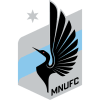We’re in the final stretch of the regular season, folks. Things are getting real. Coaches are starting to sweat. The Audi MLS Cup Playoffs are lurking just around the corner.
Last week, I looked at some of the numbers behind the Eastern Conference playoff race to try to sort out which teams deserve a playoff spot more than others. This week we’re doing the same thing with the Western Conference.
After Week 29, only six points separate the West’s fifth-place team (Real Salt Lake) from its 10th-place team (San Jose Earthquakes). The Seattle Sounders, Sporting Kansas City, Colorado Rapids and Portland Timbers look comfortable in the top four spots, but things could get a little crazy beyond that.
Using Second Spectrum’s data, we’re going to look at teams Nos. 5 to 10 in the West to see who might end up above in the seven playoff places. Like I said last week, the numbers won’t tell us everything – and they certainly won’t help us totally nail the playoff field – but they will help us learn about which teams might deserve a playoff spot more than others.
Let’s get started.
- 39 points, 28 games played
Led by MLS’ position-less wonder Damir Kreilach, Real Salt Lake have experienced a strange year. They’re currently fifth in the Western Conference, but their former manager, Freddy Juarez, left midseason to take over as an assistant coach on Brian Schmetzer’s staff in Seattle. In their eight games playing under Pablo Mastroeni, RSL have gone 4-4-0, which has been good enough to stay above the playoff line.
Statistically, RSL have been fairly average this season. They're 10th in open-play xG per game and have allowed the 12th most open-play xG per game. RSL don’t dominate the ball, but they also don’t actively avoid it (they average roughly 50% possession each game).
RSL’s possession numbers have changed from the Juarez era to Mastroeni’s time in charge – they’re stringing together fewer passes and playing narrower in possession than earlier this season. Before the coaching change in late August, the Claret & Cobalt averaged 4.5 passes per possession and 29.3 meters of attacking width in possession. Under Mastroeni, they’re averaging 4.3 passes per possession and 28 meters of attacking width.
The slightly more direct attacking style appears to be helping Real Salt Lake create more shooting opportunities. RSL’s open-play xG per game number has gone from 1.1 before the coaching change to 1.4 after the coaching change.
That’s all well and good for Real Salt Lake. The challenge is while they’re improving with the ball, they’re more vulnerable without the ball now than they were earlier this season. RSL’s open-play xG allowed per game has gone from 1.1 under Juarez to 1.5 under Mastroeni. RSL are pressing more, but not always in a very organized way, which leaves them exposed defensively.
Looking ahead to their postseason hopes, Real Salt Lake have some winnable games coming up, but Mastroeni will need to get more out of his team defensively to truly stake a claim above the playoff line.
- 39 points, 28 games played
The LA Galaxy are sitting squarely in the middle of a big ole rough patch at the moment. Winless in their last nine games, they’ve gone from near the top of the Western Conference to sitting just inside the top seven.
Still, despite their poor run last six weeks, LA usually haven’t been played off the field. Their xG per game has dipped, but their xG allowed per game has actually improved since the winless streak started in mid-August.
While the Galaxy aren’t incredibly effective at turning possession into goalscoring chances (they’re just 14th in MLS in xG per game), they’re one of the best teams in the league at controlling possession. No team in MLS averages more passes per possession or longer possessions than Greg Vanney’s Galaxy team – and few teams stretch the field more in possession than LA.
As they showed in Sunday night’s 1-1 draw with LAFC, the Galaxy can create danger with the ball. Samuel Grandsir’s goal in the 19th minute was a result of a beautiful possession play that started from goalkeeper Jonathan Bond, moved up the right wing and ended with Victor Vazquez threading a ball in behind for Grandsir.
Moments like the above goal are too few and far between for LA, but they are there – and opposing defenses have to be wary of giving Vanney’s team too much space to work with.
Defensively, the LA Galaxy have improved over the past two months, but they’re still in the bottom half of the league in terms of xG allowed per game. The Galaxy have the quality to stay above the playoff line and even do some damage in the postseason, but their future success hinges on creating more consistent danger in possession and limiting their opponents’ danger in possession.
- 38 points, 27 games played
Though their recent results have been somewhat mixed, the data likes Minnesota United. The Loons are currently seventh in the Western Conference, but many of Second Spectrum’s metrics have them higher up the statistical table.
Let’s start with some offensive numbers.
When they have the ball, Adrian Heath’s squad can create chances in both open-play and dead-ball situations. Minnesota are seventh in MLS in open-play xG per game and eighth in average xG created from corner kicks and free kicks. They average the second-most passes received between the lines per game in the league, with Romain Metanire, Emanuel Reynoso and Franco Fragapane all top five in terms of between-the-lines passing per game in MLS.
Defensively, Minnesota United allow the ninth smallest open-play xG total per game in MLS (1.06). With the fifth smallest xG total allowed while organized, Minnesota excel at using their set defensive shape to smother opposing attacks. The Loons are more open in transition, however. They allow the 19th most xG per game while defending in transition, which could be an issue during the final games of the regular season.
Even acknowledging that defensive blemish, there are still plenty of other metrics that paint Minnesota United in a favorable light: they have the ninth-best pressing efficiency in MLS, the 11th best pressing efficiency in the attacking third, and they average the seventh most team-wide high presses per game.
To be elementary: They pressure the ball a lot and they win the ball a lot.
With an elite playmaker like Reynoso leading their attacks and a strong defensive unit working behind him, Minnesota United look primed to finish the regular season strong and head into the playoffs with momentum on their side.
- 37 points, 27 games played
Like RSL, Vancouver have gone through a coaching change this season. Under interim manager Vanni Sartini, the Whitecaps have gone 4-1-2 in seven games and are pushing up right underneath the playoff line.
Vancouver aren’t a perfect team – and moving on from Marc Dos Santos didn’t magically fix all their problems. The Whitecaps struggle defensively, allowing the ninth most xG this season and failing to win the ball regularly after applying defensive pressure.
With the ball, though, the Whitecaps have enjoyed some notable improvements since their coaching change in late August. Before Dos Santos left on August 27, the Whitecaps were borderline toothless in the attack, averaging just 0.95 open-play xG per game, which was 24th in MLS. Over their last seven games, that xG number has ballooned up to 1.3 per game. That’s a pretty big jump!
At least part of the reason behind Vancouver’s increased offensive work is the team’s more aggressive approach in possession. The Whitecaps’ possessions are shorter now than they were under Dos Santos – they’re also narrower and they include fewer passes. In the final third, Vancouver are much more active than they were earlier this season. Dos Santos’ Whitecaps were 22nd in MLS in runs in the final third per possession. Sartini’s Whitecaps are eighth.
They still have to get over the playoff line, but with a much-improved, energized attack, Vancouver have moved into legitimate playoff contention over the last month.
- 34 points, 28 games played
This felt almost impossible at the beginning of the season, but it’s happening right before our eyes: LAFC are outside of the playoff field with six games left in the regular season. Bob Bradley’s team is hanging on for dear life right now, desperately trying to claw their way into the Western Conference’s top seven spots.
Interestingly enough, despite LAFC’s poor season, the gap between their underlying numbers and their actual on-field output is gigantic. The stats love LAFC. Right now, they’re second in open-play xG per game, sixth in open-play xG allowed per game and second in pressing efficiency. And yet, despite those numbers, LAFC have been a pretty mediocre offensive team output-wise. They’re 15th in MLS in goals scored in open-play and they’ve allowed the sixth most open-play goals in the league.
It’s pretty rare to have a team with such disparate expected goals and actual goals numbers – and it’s hard to say exactly why we’re seeing a large gap between those two things with LAFC.
Still, a few things have changed for LAFC this year. They’ve played much of the season without Carlos Vela, Diego Rossi is now on loan with Fenerbahçe in Turkey and Eddie Segura is out for the year with a knee injury. Other players have dealt with injuries or been moved to other clubs as well.
The squad has changed – and Bradley’s shape and approach have changed, too. LAFC are one of the teams that have moved to a three-at-the-back shape for much of this season. Bradley has used a three center back shape for more than 50% of his team’s possessions this year, which is a much higher percentage than in years past. In possession, LAFC are more direct than they were in 2020: they pass the ball less, spend less time on the ball per possession and don’t spread as wide as they did last year.
Those offensive adjustments don’t necessarily explain why LAFC are underperforming their expected numbers by such a wide margin, but they could have something to do with the team’s struggles in 2021. Even without some of their stars, it’s hard to count LAFC out of the postseason, but if they don’t find a way to string together results, their 2021 may end earlier than we all expected.
- 33 points, 28 games played
The San Jose Earthquakes love to exist right on the playoff bubble. In 2019, they finished eighth. In 2020, they finished eighth. They’re further down the table this year, but they do have an outside chance of sneaking into the postseason.
Looking at the data, Second Spectrum’s numbers don’t shine a particularly favorable light on the Quakes' season. They haven’t created consistent attacking chances and are currently 18th in open-play xG generated per game.
Defensively, the Earthquakes are one of the leakiest, if not the leakiest, teams in MLS – they allow more xG per game than any other team in the league. Despite Matias Almeyda’s shift away from man-marking, San Jose still have issues shutting down opposition attacks.
Though they rarely high-press, the Quakes are a solid pressing team in other areas of the field – their 41.9% pressing efficiency is 11th in the league. Still, with their inability to stop opposing teams from creating combined with their own chance creation struggles, climbing up into the West’s top seven spots may be too tall a task.



















